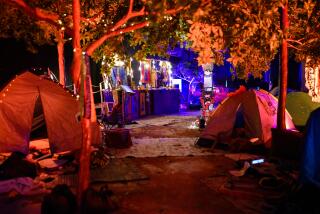Birth of a Nation
- Share via
On the occasion of Israel’s 50th anniversary, the Finegood Gallery in West Hills is presenting a timely tribute. On the face of it, it appears to be a humble offering, but there’s more to the story than immediately greets the eye. Lining the gallery walls are color blowups of photographs by Marlin Levin, an American-born journalist who has been in Israel since emigrating there in 1947, the year he began snapping these pictures.
The show ultimately functions as a rough-hewn slice-of-life portrait, but what a life. Israel’s story is a unique one, in which a blend of tenderness, idealism and vulnerability surrounds that most unusual occurrence in our time--the birth of a nation. Of course, it was a painful birth, just as it has been and continues to be a painful life, but there’s no denying the courage and will that fueled its beginnings a half-century ago.
Photographic chronicles, such as the one here, can’t really hope to capture the underlying spirit or intangibles of life there. Somehow, though, Levin’s unassuming images manage to convey something strong and evocative, presenting a portrait of a landscape-in-the-making, an ancient land in transition, again.
The photographs are anything but slick or especially artful, with uneven attention paid to composition and focus. It looks like the seat-of-the-pants aesthetic at work, by a photographer racing to create a candid document rather than make art for posterity’s sake. But the sum is greater than the parts here: The rawness accounts for its charm, with nothing maudlin or cerebral to disrupt the urge to chronicle a historic moment.
The composite portrait is one that takes in the cultural-historical dichotomy that is Israel, where old, venerable and sometimes crumbling surfaces meld with the youthful countenance of a new state. “Nazareth Unchanged” is a humble village scene that could be from the 19th century. The elderly man on horseback in “Riding to Work” is in marked contrast with the proud urbanity of a smug man in a polished convertible, in “Foreign Correspondent in Jerusalem.”
Street life rears its head in the form of parades of soldiers--including a group of rifle-toting female infantrypersons in “Our Heroines”--newly appointed dignitaries and other displays of solidarity. In “First Independence Day, 1949,” the lens peers up at a building with citizens literally bulging out of its orifices--gathered in a mad, happy crush at the windows and balconies.
Underscoring the military presence in these photographs is the fact that the army in Israel is more than ceremonial, of course. It is an important aspect of the social fabric. “Blessing the New Israeli Army” shows a ceremony in which a rabbi blesses military officers, a case of church and state colluding, without qualms.
While there are no explicit images from the battlefront, grimmer realities of Israeli life appear, as with the spartan conditions pictured in “Bartering Bread for Water.” Danger lurks, and sometimes strikes, then as now, and citizens learn to live with the fear. So it’s not startling to find men walking matter-of-factly past a hastily constructed “Anti-Sniper Wall,” a symbol of terror lining the everyday. That life continues today, as Israelis live in potential peril, but also with high ideals and a sense of hard-won cultural fortitude.
One of the most memorable images here is also one of the simplest. “First Water in Jerusalem” is a tight close-up of water trickling out of a pipe. The water itself is in sharp focus, while the apparatus that delivers it is fuzzy, a necessary machinery in the background. As an image of fluidity and freedom, its metaphorical resonance is clearly stated, without being overstated.
Also in the gallery are black-and-white photographs of Ruth Gruber, circa 1940-1950. Her images from the Cypress Prison Camp, and from the refugee ships Exodus and the Runnymede Park, offer a grittier view of the human saga leading to Israel’s formation. Also on view, Chanan Getraide’s recent snapshots show modern Israel, for good measure.
BE THERE
“Birth of Israel Exhibit (1948-1998)” at the Finegood Art Gallery, at the Bernard Milken Jewish Community Center, 22622 Vanowen St., West Hills. 10 a.m.-9 p.m. Monday-Thursday; 10 a.m.-3 p.m. Friday; 10 a.m.-5 p.m. Sunday; (818) 716-1773.
FOR PIX SLUGGED FINEGOOD 3, above, FINEGOOD.2, below left, and FINEGOOD.1, below right, 1-2 lines
More to Read
The biggest entertainment stories
Get our big stories about Hollywood, film, television, music, arts, culture and more right in your inbox as soon as they publish.
You may occasionally receive promotional content from the Los Angeles Times.










